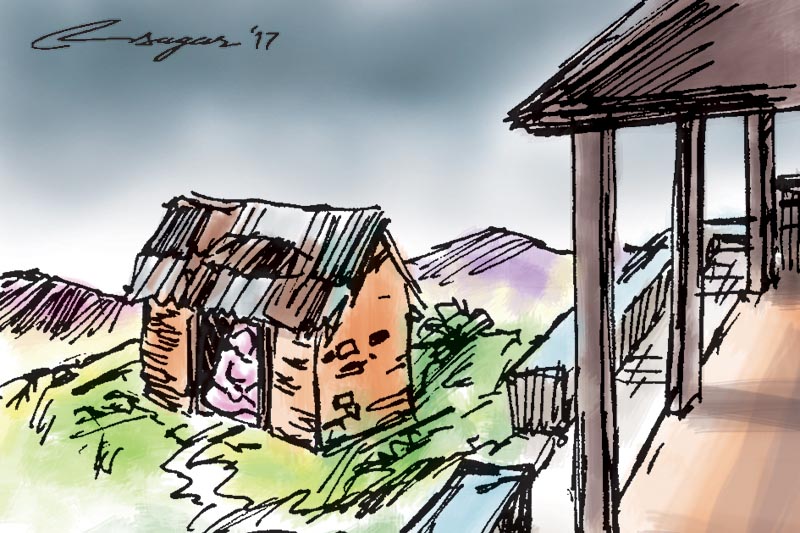Criminal Code: Chhaupadi and community
The key stakeholders should plan and implement the programmes and activities that are accepted by the community people with great willingness, rather than forcibly
The recently endorsed Criminal Code of Nepal regarding Chhaupadi—a culture of banishment of girls or women during periods or postpartum, highly prevalent in the mid-and far-western hilly region— as one form of crimes, is a praiseworthy event in the sector of gender equity and discrimination. Will this intervention be a panacea for elimination or eradication of Chhaupadi? Or will it be fruitless as that of the ban of the same norm by the apex court in 2005?
The revised Criminal Code vividly mentions that any discrimination or inhumane behavior during the menstrual or postpartum periods such as Chhaupadi or any other forms of discrimination, are strictly prohibited; and practice of such shall be considered a criminal offense; with a sentence of three month’s imprisonment and a fine of Rs. 3000. The penalty itself seems somewhat slight in nature whereas on the flip side, its effective implementation is essential.
Even after various interventions and money invested to declare “Chhaupadi free VDCs”, we are forced to hear about casualties of girls and women, making the efforts go in vain. Chhaupadi norm was outlawed by the apex court in 2005; however, only in Achham—one of the remotest districts of the far-west—it has caused deaths of as many as nine women in the last nine years as stated by the district women and child development office in 2016. Apart from fatality, from the perspective of health, nutrition and education, girls and women suffer from different forms of hardship during their periods.
Regarding the recent endorsement of the Criminal Code, are we serious about the aspect that an innocent girl or woman practicing Chhaupadi will take steps to go against their parents or guardians penalizing them according to the latest Criminal Code? Obviously, the answer is “no”. Although the code seems laudable, it is not enough to eliminate this problem: the challenge is much more deeply rooted and multidimensional. Therefore, the approach to eliminate it should be comprehensive and multifaceted in nature, and rather unilateral.
Even though, the girls and women in cities, are also practicing Chhhuapadi during periods, why don’t we encounter news of their death there, but only in the countryside? The reason of fatality in rural areas is Chhaugoth—an ill-ventilated, dark and small makeshift hut— where the girls and women are compelled to stay for a few days, isolating themselves from family and relatives.
These sheds are prepared usually 20-25 meters away from residential homes and sometimes far away from home. Such sheds are very narrow, dark, cold, congested and suffocating due to poor ventilation.
Fatalities in the past, were found to be caused by suffocation, acute respiratory infections, animal or snake bites and sometimes physical and sexual assaults, due to the structure and location of the huts. In contrast, the girls in cities practice Chhaupadi in a room within the house with proper hygiene, and they should not have to suffer banishment. That’s why, what we need now is the modification of the Chhaupadi norm, not its eradication. Radical change is unattainable in a single generation.
Once, there was a campaign of Chhaugoth destruction in the name of Chhaupadi elimination, which seemed completely ridiculous. I just want to share why the Chhaugoth destruction is worthless with an example. While working as a public health officer in Achham, I was astonished by the news that a mourning mother who had lost her daughter a few days before was seen to practice Chhaupadi after a few days by building another hut: the former was destroyed by the authorities after that gloomy incident.
The aforementioned truth is a great challenge for the proponents of Chhaugoth destruction and the legal approach to Chhaupadi elimination. What we need now is remodeling of the harmful culture with innovative approaches as we can’t root out deeply entrenched norms by a magic bullet. Destruction of Chhaugoth is not the solution of the problem but the destruction of mindset to practice chhaupadi is the needs of many generations.
Although it seems paradoxical; It would have been effective to prevent casualties if the resources invested to destroy the hut had been utilized to establish modified versions of Chhaugoth—hygienic, and located nearby residential area with adequate ventilation.
WHO has recommended that efforts to change harmful traditions are most effective when they originate within the culture practiced by the people themselves. The key stakeholders should plan and implement the programmes and activities that are accepted by the community people with great willingness, rather than forcibly.
What is clear till now is the legal approach only will not bring change; that’s why a comprehensive model is needed. Along with effective implementation of a legal approach, if we innovate the modified version of Chhaupadi norm—through intensive discussion with key stakeholders—it will be more acceptable to the community people. This could be a “win-win approach” both for the community and the stakeholders.






